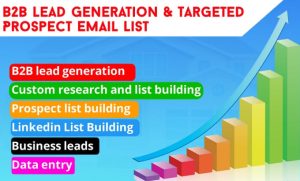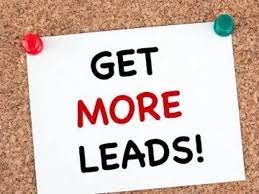Your B2B prospect list is the foundation of your entire sales and marketing operation. Get it right, and you have a direct pipeline to revenue. Get it wrong, and your sales team is left shouting into a digital void, wasting time and resources on leads that were never going to buy.
The era of “spray and pray” buying a massive, generic list and blasting it with a one-size-fits-all email is over. It doesn’t just yield poor results; it damages your brand’s reputation and gets your domain blacklisted.
The secret to success isn’t a bigger list; it’s a smarter list. It’s a strategically built, highly-qualified, and deeply understood list of companies and individuals who have a genuine need for your solution.

This guide will walk you through the five essential steps to build a B2B prospect list that doesn’t just sit in your CRM it actively converts.
1. Lay the Cornerstone with Your Ideal Customer Profile
You cannot find who you’re looking for if you don’t know who they are. This is the single most critical step, and skipping it is the primary reason most prospect lists fail.
What it is: An Ideal Customer Profile (ICP) is a detailed description of the perfect company for your product or service, not the individual person. It’s a fictional company that gets the most value from your solution and, in turn, provides the most value to you (e.g., high lifetime value, low churn, great case studies).
How to build it deeply: An ICP goes far beyond basic demographics. It’s a multi-layered profile built on data.
- Firmographics (The “Who”): This is your baseline.
- Industry/Vertical (e.g., FinTech, Healthcare IT, E-commerce)
- Company Size (by employee count or annual revenue)
- Geographical Location (city, state, country, or region)
- Company Structure (e.g., B2B, B2C, D2C, Non-profit)
- Technographics (The “What they use”): This data is a goldmine for relevance.
- What CRM do they use?
- What marketing automation platform?
- Are they using a competitor’s product?
- What is their website built on?
- Behavioral Data & Buying Signals (The “When and Why”): This is what makes your list timely.
- Trigger Events: Have they recently received a new round of funding? Hired a key executive (like a new VP of Sales)? Announced an expansion? These events often signal a new need and an open budget.
- Engagement: Have they downloaded one of your lead magnets (e.g., an ebook or whitepaper)? Attended a webinar? Followed your company on LinkedIn?
2. Source Your Prospects with Precision
With your ICP as your map, you can now go hunting. The goal is to find companies that match your ICP criteria, and then identify the right people within them (buyer personas).
Here are the most effective sales prospecting sources, broken down by intent:
High-Intent Inbound Sources
These are your warmest leads because they’ve already shown interest.
- Content Downloads & Webinar Registrations: Someone who gave you their email in exchange for your “Ultimate Guide to Supply Chain Management” is actively researching that topic. These are marketing qualified leads (MQLs) that need to be followed up swiftly.
- Contact Us : This is the highest-intent signal possible. They are explicitly asking to talk to sales. These leads should be at the top of your list and contacted within minutes, not hours.
Proactive Outbound Sourcing
Here, you use your ICP to proactively find prospects who haven’t discovered you yet.
- LinkedIn Sales Navigator: This is arguably the most powerful tool for B2B prospecting List. Don’t just browse; use its advanced filters to surgically target your ICP. Filter by company size, industry, geography, job title, seniority level, and even keywords in their profile (e.g., “SaaS growth”). Use it to identify the specific decision-makers and influencers within your target accounts.
- B2B Company Databases: In the market are massive databases of company and contact information. They are incredibly valuable for building a list at scale. You can filter by hundreds of firmographic and technographic data points to generate a list of companies that match your ICP, then purchase the verified contact info for the relevant buyer personas.
- Industry Events & Trade Associations: Look at the attendee and sponsor lists from major industry conferences. These companies have self-selected as being serious players in your space. The same goes for members of trade associations.
3. Qualify and Enrich Your Data
You now have a raw list of companies and contacts. The next step is to ensure the data is accurate and the leads are actually qualified. A list full of bad data is useless.
Deep Dive on Qualification:
Qualification is the process of determining if a prospect is a good fit. A popular framework is BANT:
- Budget: Do they have the financial capacity to purchase your solution?
- Authority: Is this contact the decision-maker, or can they influence the decision?
- Need: Is there a clear pain point that your product solves for their business?
- Timeline: Are they looking to implement a solution in the near future?
Deep Dive on Data Enrichment & Verification:
A name and an email aren’t enough for effective outreach. Data enrichment is the process of appending more information to your contacts.
- What to add: Job title, direct dial phone number, company firmographics, LinkedIn profile URL.
- Why it matters: This data fuels personalization. Knowing a prospect’s role allows you to tailor your message to their specific pain points.
- How to do it: Use data enrichment tools (many of the B2B databases listed above also offer enrichment services) to automatically fill in the gaps in your existing records.
Finally, run your list through an Data verification service (e.g., NeverBounce, ZeroBounce). This crucial step cleans your list of invalid, misspelled, or defunct emails, protecting your sender reputation and dramatically improving deliverability.
4. Segment Your List for Hyper-Personalization
You would never send the same message to a CEO and a Marketing Manager. So why would you send the same message to every prospect on your list?
List segmentation is the practice of dividing your prospect list into smaller, more manageable sub-groups based on shared characteristics. This is the foundation of any successful account-based marketing or targeted outreach campaign.
How to Segment Deeply:
- By Industry: A financial services company has different compliance concerns and vocabulary than a manufacturing company. Tailor your case studies and language accordingly.
- By Job Role / Persona: A CFO cares about ROI and cost savings. A CTO cares about integration, security, and technical debt. A Head of Sales cares about revenue growth and team efficiency. Your outreach must speak to their world.
- By Pain Point: Group prospects who are likely experiencing a similar problem. For example, you could create a segment of “Companies who are hiring sales reps” because they will likely have a need for your sales training software.
- By Technology Used: Create a segment of prospects using a competitor’s tool and craft a message around your key differentiators. Create another segment for those using a complementary technology and frame your product as the perfect addition.
Segmentation allows you to move from “Dear Sir/Madam” to a hyper-personalized outreach message that resonates deeply and proves you’ve done your homework.
5. Integrate, Track, and Refine
Your prospect list is a living asset, not a one-time project. It must be integrated into your Customer Relationship Management (CRM) system to become actionable.
Creating a Feedback Loop:
Your CRM is the central nervous system of your sales process. As your sales team works the list, they will generate invaluable data.
- Track Everything: Open rates, reply rates, meetings booked, and ultimately, conversion rates for each segment.
- Analyze the Results: Are you getting a low reply rate from the “Manufacturing” segment? Perhaps your value proposition isn’t resonating. Is the “VP of Marketing” persona converting better than the “CMO”? Double down on that persona.
- Refine Your ICP: This feedback loop directly informs your ICP. If you discover that companies with 50-100 employees convert at a much higher rate than those with 500+, update your ICP to reflect this. This makes your next round of prospecting even more efficient.

This continuous cycle of building, engaging, tracking, and refining is what transforms prospecting from a guessing game into a predictable revenue generation engine.
Conclusion: Quality is the New Scale
At Leadavail building a B2B prospect list that converts is a shift in mindset. It’s a move away from brute force and toward strategic precision. It prioritizes a deep understanding of who you’re selling to over the vanity metric of list size.
By laying a strong foundation with your ICP, sourcing intelligently, qualifying ruthlessly, segmenting for relevance, and constantly refining your approach, you will build more than a list. You will build a high-octane sales pipeline filled with prospects who are not just willing to listen, but are primed to convert.
